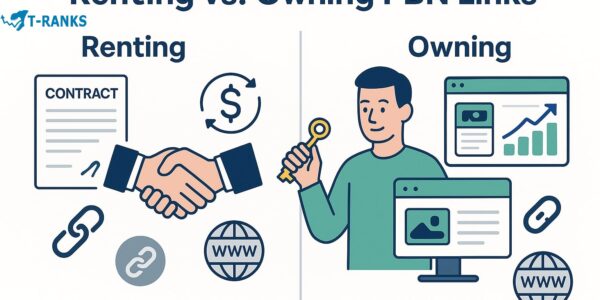If you’re trying to boost your website’s rankings, you’ve probably considered using PBN links. But should you rent PBN links from someone else, or build and manage your own network? Each option has its pros and cons, and choosing the wrong one could waste time, money, or even trigger a Google penalty.
In this guide, you’ll learn the key differences between renting and owning PBN links, when each makes sense, the risks involved, and smarter link-building alternatives. Whether you’re new to SEO or exploring advanced backlink strategies, this article breaks it all down in simple terms.
Key Highlights
- ✅ Renting PBN links is faster and cheaper upfront but offers less control and higher risk.
- ✅ Owning a PBN provides full control and long-term SEO value but demands high investment and technical expertise.
- ✅ Short-term campaigns benefit from rented links, while long-term SEO strategies favor ownership.
- ✅ Common pitfalls include over-optimized anchors, footprints, and low-quality domains.
- ✅ Best practices involve vetting providers, tracking link health, and avoiding over-optimization.
- ✅ Safer alternatives include guest posting, niche edits, HARO links, and digital PR.
- ✅ Combine white-hat SEO with limited PBN usage for safer, scalable link building in 2025.
What Are PBN Links?
Private Blog Network (PBN) links are backlinks placed on a network of privately controlled websites, built primarily to manipulate search engine rankings.
IF used strategically, they allow SEOs to control anchor text, link placement, and content context—offering faster ranking potential than traditional outreach.
These networks are usually created from aged or expired domains that still carry authority. In 2025, PBN links remain common in competitive and gray-hat niches but are riskier due to Google’s improved detection systems like SpamBrain and Link Spam Updates.
Despite being against Google’s guidelines, PBNs are still used by agencies, affiliates, and SEOs who need speed, control, and scale in their link-building strategies.
Renting PBN Links: What You Need to Know
Renting PBN links means paying for temporary backlink placement on someone else’s private blog network. The provider handles domains, content, and hosting. You pay monthly or yearly and get a link pointing to your site.
This is a fast, affordable option for short-term SEO campaigns. It’s also low-maintenance, which makes it appealing for startups or affiliate projects.
To safely rent PBN links in 2025, check the basics:
- Domain Rating or DA above 20
- Clean backlink profile (use Ahrefs or SEMrush)
- Low outbound links (ideally under 8 per page)
- Niche relevance
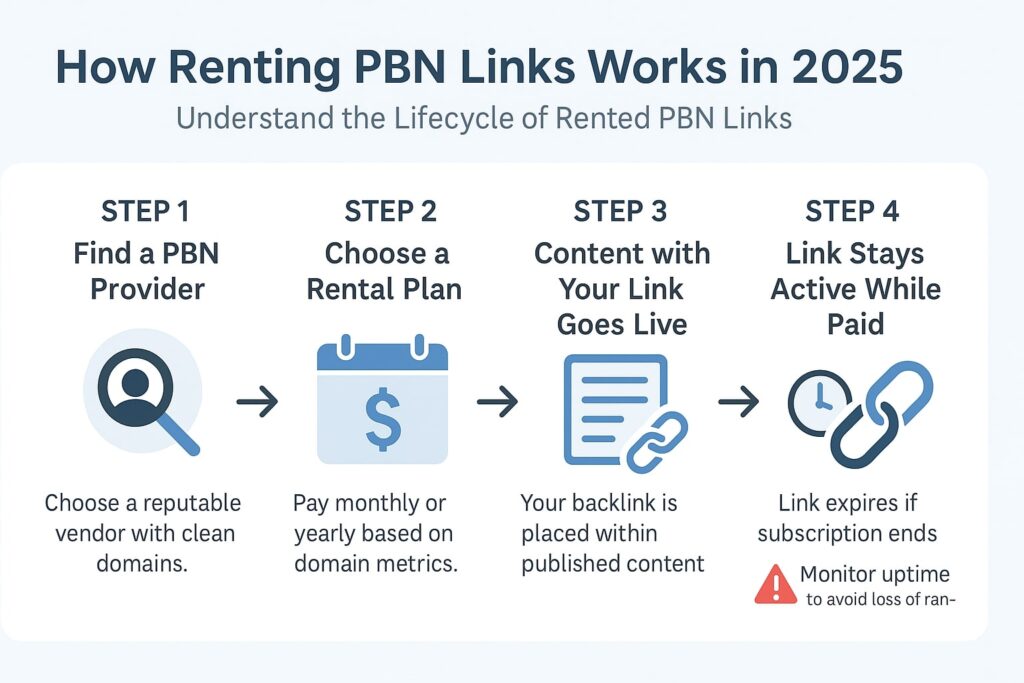
1. Pricing & Subscription Models
Most rented links cost $20 to $100 per month. Prices depend on domain authority, niche, and placement type.
6-month rentals are ideal for affiliate pushes or seasonal pages. They usually include content and link checks.
12-month rentals cost more but offer better link stability. Some providers give bulk discounts.
Packages typically include a 300–500 word article, a contextual backlink, and basic site maintenance.
For tougher verticals like tech or gambling, expect to pay toward the higher end of the range.
If you’re unsure how many PBN links to rank with, compare backlink profiles against your top competitors.
2. Link Lifespan & Maintenance
Rented links stay live only during your subscription. When the term ends, the link is often removed—unless renewed.
What happens if you stop paying?
- Link is deleted
- Rankings may drop
- You lose link equity
- Some providers may not warn you
This is why monitoring matters. Use SEO tools or dashboards to check if links stay indexed and active.
Some providers also rotate content, change URLs, or lose control of domains. Even if the link is live, it may stop passing value.
Using good PBN management tools helps you keep track of everything.
3. Risk Factors in Renting
Renting seems easy—but it comes with risk.
- Providers may lose domains (a 2025 study found 15.5% of expired domains used in PBNs dropped within a year)
- Canceled subscriptions = link deletion
- You can’t change anchors or update content
- Some networks block Ahrefs or Majestic, making it hard to check links
Poor-quality networks often leave obvious footprints—shared themes, repeated IPs, spun content. These raise red flags with Google.
To improve your Google ranking with PBN links, only work with providers like T-RANKS who use aged, clean domains and avoid suspicious patterns.
Owning PBN Links – Pros and Cons
Owning a Private Blog Network (PBN) gives you full control over backlinks. You choose which domains to buy, what to publish, and how to link to your site.
IF done properly, this strategy can support long-term rankings and cost savings. But it also carries serious risks and demands ongoing work.
1. Setup & Investment
To own a PBN, you need to buy expired or aged domains that still have backlinks and authority. These domains must be clean, niche-relevant, and free from penalties.
You’ll need to:
- Check domain history using tools like Wayback Machine or SpamZilla
- Buy hosting with separate IPs and registrars to avoid footprints
- Install WordPress and upload custom content
- Add contextual backlinks to your target site
Costs:
- $2,000–$3,000 per domain (depending on authority and backlink profile)
- $10–$30/month per site for hosting, indexing tools, and security
- $10–$50 per article for original content
- A 10-site PBN can cost up to $30,000 to build
🟢 Pros:
- Builds long-term SEO assets
- You control backlink quality and source
- Niche-specific domains boost topical authority
🔴 Cons:
- High initial cost
- Setup errors can lead to penalties
- Buying poor-quality domains can damage your rankings
2. Control & Customization
With ownership, you control everything—content, design, links, and timing.
You can:
- Customize anchor text ratios (e.g., 50% branded, 20% partial match)
- Test different link types (homepage vs. inner page)
- Link between your PBN sites to boost topical depth
- Match branding and voice to your money site
- Schedule posts to mimic organic growth
This level of control lets you experiment safely—without relying on vendors or marketplaces.
🟢 Pros:
- Full backlink and anchor text control
- Easier to scale for agencies
- Faster ranking results compared to white-hat SEO
🔴 Cons:
- Requires SEO knowledge to stay safe
- Over-optimization can trigger SpamBrain penalties
- Poor design or link structure may reveal your network
3. Maintenance Demands
Owning a PBN is not “set it and forget it.” You must maintain each site regularly.
Ongoing tasks include:
- Updating plugins, themes, and CMS to avoid security risks
- Publishing new content monthly to keep sites indexed
- Monitoring backlinks, index status, and site health
- Avoiding footprints (unique IPs, different themes, WHOIS privacy)
You’ll also need a tool or SOP to track all domains, anchors, expiry dates, and hosting accounts.
🟢 Pros:
- You control site health and link performance
- Well-managed PBNs can stay undetected for years
🔴 Cons:
- Time-consuming to manage
- One mistake (e.g., shared plugin or IP) can expose the network
- If a single site gets penalized, others may be traced
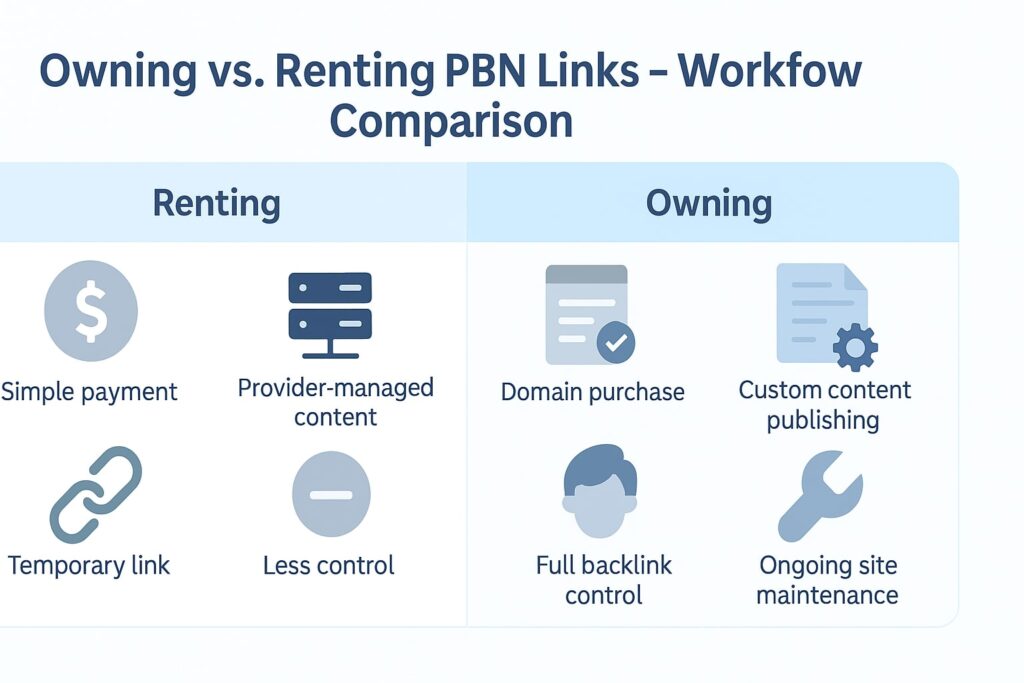
Summary: Is Owning a PBN Worth It?
Owning PBN links works best if you need control, long-term assets, and already have SEO experience.
But it’s not for everyone. The cost, risk, and time involved can overwhelm beginners or low-budget projects.
For safer options, some SEOs use a hybrid approach—rent PBN links for speed, while building owned networks in the background.
Rent vs Own – ROI Comparison
Is it better to rent or own PBN links in 2025?
If your SEO strategy favors speed and low effort, renting offers fast traction. IF you’re building authority for long-term gain, owning gives full control—but also carries bigger risks and costs.
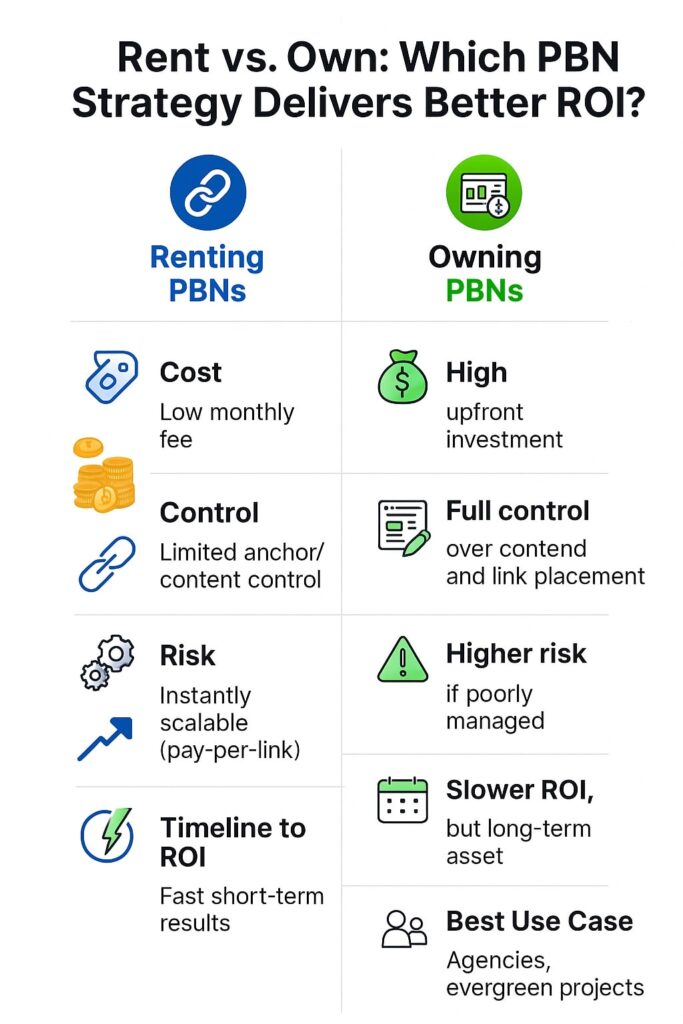
Here’s a complete ROI breakdown of both approaches:
Rent vs Own Comparison
Cost
- Renting: $20–$100 per link monthly
- Owning: $2,000–$3,000 per domain + $10–$30/month for hosting, proxies, and content
Ongoing Maintenance
- Renting: None—handled by provider
- Owning: Requires monthly updates, renewals, and security checks
Control
- Renting: Limited control over placement and anchor text
- Owning: Full freedom to optimize anchor text, site layout, and link timing
➡️ Improve your anchor text strategy
Link Strength / Quality
- Renting: Varies by provider—some networks may be overused or hidden
- Owning: High-quality links possible if you use clean, niche-relevant domains
Scalability
- Renting: Easy to scale links up or down quickly
- Owning: Slower to expand; requires domain sourcing and tech setup
Longevity
- Renting: Temporary—links disappear after cancellation
- Owning: Permanent links, as long as sites are live and maintained
SEO Risk
- Renting: High if provider reuses networks or blocks crawlers
- Owning: Also high—footprints, cross-linking, and poor site quality can trigger penalties
➡️ Learn how to hide PBN links to reduce exposure
Timeline to ROI
- Renting: Immediate boost—ideal for short-term campaigns
- Owning: Slower payback, but better ROI over time if managed well
Dependency
- Renting: Fully dependent on provider reliability and network health
- Owning: Self-managed, no third-party reliance
Long-Term Value
- Renting: Drops to zero if links are removed
- Owning: Higher long-term value if network stays healthy
Recovery Risk
- Renting: Easier to cut ties, but sudden deindexing is possible
- Owning: Harder to recover if network is penalized—may affect all linked sites
Monetization Potential
- Renting: Not applicable
- Owning: Can be monetized by selling links (with caution)
Best For
- Renting: Affiliate sites, tests, startups, and short-term SEO
- Owning: Agencies, evergreen niches, and long-term SEO asset building
Verdict
- Choose renting for quick SEO wins, minimal responsibility, and budget flexibility
- Choose owning if you’re building sustainable, high-volume SEO with full control
But both strategies carry risk—especially as Google strengthens SpamBrain and link spam detection.
Match your choice to your timeline, budget, and risk tolerance to make it worth the investment.
ROI Snapshot: Rent vs. Own PBN Links
| Factor | Renting PBN Links | Owning PBN Links |
| Cost | $20–$100/link/month | $2,000–$3,000+ per domain + monthly hosting |
| Control | Limited (provider decides anchors & content) | Full control over anchor text and placement |
| Maintenance | None – handled by provider | Ongoing – content, hosting, indexing |
| Longevity | Temporary – links removed after rental ends | Permanent – links stay live if managed properly |
| SEO Risk | High (low-quality providers, network penalties) | High (footprints, deindexing risk) |
| Timeline to ROI | Fast results during rental period | Slower, builds SEO assets over time |
| Best For | Short-term wins, affiliate launches | Agencies, evergreen niches, long-term SEO plans |
When Does It Make Sense to Rent PBN Links Instead of Owning Them?
Renting PBN links is the better choice when you need fast SEO results, have a limited budget, or lack the time and skills to manage a private network. It’s especially useful for short-term projects, experimental campaigns, or solopreneurs seeking low-commitment link building.
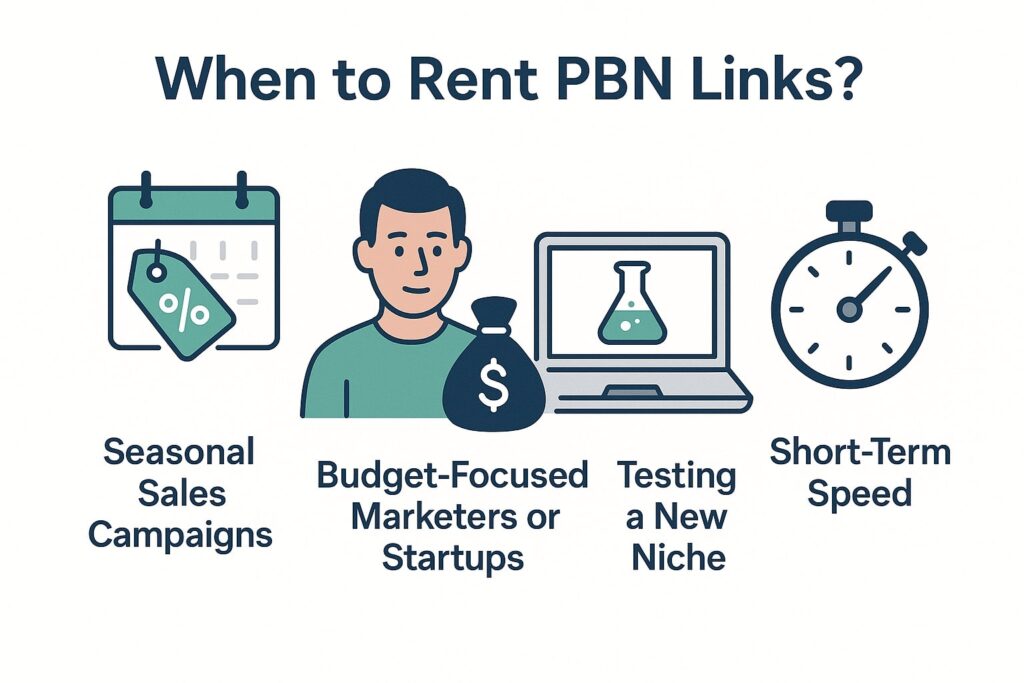
Short-term SEO campaigns benefit most from rented PBN links
If you’re running an affiliate launch, flash sale, or seasonal push, renting offers temporary ranking power without building long-term assets. It’s efficient for holiday promos or niche events where results are needed fast, then the links can be removed when no longer needed. You can see how many PBN links you need to rank on Google to better plan these short campaigns.
Startups and small businesses can rent PBN links to avoid large upfront costs
Instead of investing thousands into domains, content, and infrastructure, renting provides access to existing link equity without the heavy setup. It’s ideal for early-stage sites testing SEO traction or validating new markets. Many rely on PBN management tools to track placements and maintain visibility without technical hassle.
Testing new niches or strategies is safer with short-term rentals
Whether you’re exploring crypto, CBD, adult, or emerging markets, renting lets you gauge SERP responsiveness with minimal risk. You can evaluate ROI using 3–6 month rental cycles before committing to a larger SEO play.
Renting is a safer route if you lack the skills or time to manage a PBN
Building and maintaining a private network requires SEO expertise: managing footprints, indexing, hosting, and link safety. If you’re not yet confident in how to build PBN links, renting from a quality provider gives you similar benefits without the backend stress.
Smart use of rented links can also supplement your overall SEO strategy
When combined with natural links, guest posts, and branded anchors, rented links help diversify your profile—especially in competitive or link-starved niches.
When Is Owning a PBN the Smarter Investment?
Owning a PBN gives you full control and long-term flexibility, making it a strong choice for businesses that want sustainable SEO assets. It’s best suited for brands focused on growth, agencies managing multiple clients, or experienced SEOs building long-term authority.
You want full control over link strategies
When you own the network, you choose where every link goes—what anchor text is used, what content surrounds it, and when it’s published. This helps you avoid over-optimization and target keywords safely. You don’t rely on anyone else, and no links disappear if a provider shuts down.
Long-term projects need long-term assets
If you’re running evergreen content in niches like health, finance, or education, owning your backlinks makes sense. Unlike rented links, which disappear if you stop paying, your owned links stay active as long as your domains and hosting are maintained.
You manage clients or high-volume SEO
Agencies and SEOs running multiple websites benefit from PBN ownership. A single well-built network can support dozens of money sites, saving thousands in recurring rental costs. You can customize each site to match different client niches.
Better return over time
Owning a PBN costs more upfront—domain purchases, hosting, content—but can be cheaper in the long run. You’re building a long-term SEO asset you can reuse and scale across projects. If you manage everything well, there’s less risk of deindexing or ranking loss.
You already know how to manage SEO risks
PBNs are risky if mismanaged. But if you know how to avoid PBN link footprints, keep your sites clean, and stagger your link placements, owning becomes a powerful strategy. It’s ideal for SEOs with experience or teams with technical skills.
It works well when combined with white-hat SEO
Some SEOs use a hybrid model—owning a small, well-managed PBN alongside guest posting, content marketing, or HARO link building. This way, they keep their link profile diverse and reduce the risk of penalties.
Common Pitfalls in Renting or Owning PBNs
Whether you choose to rent or own PBN links, certain risks can undermine your SEO strategy if not addressed properly. Below are the most common pitfalls—and how to avoid them.
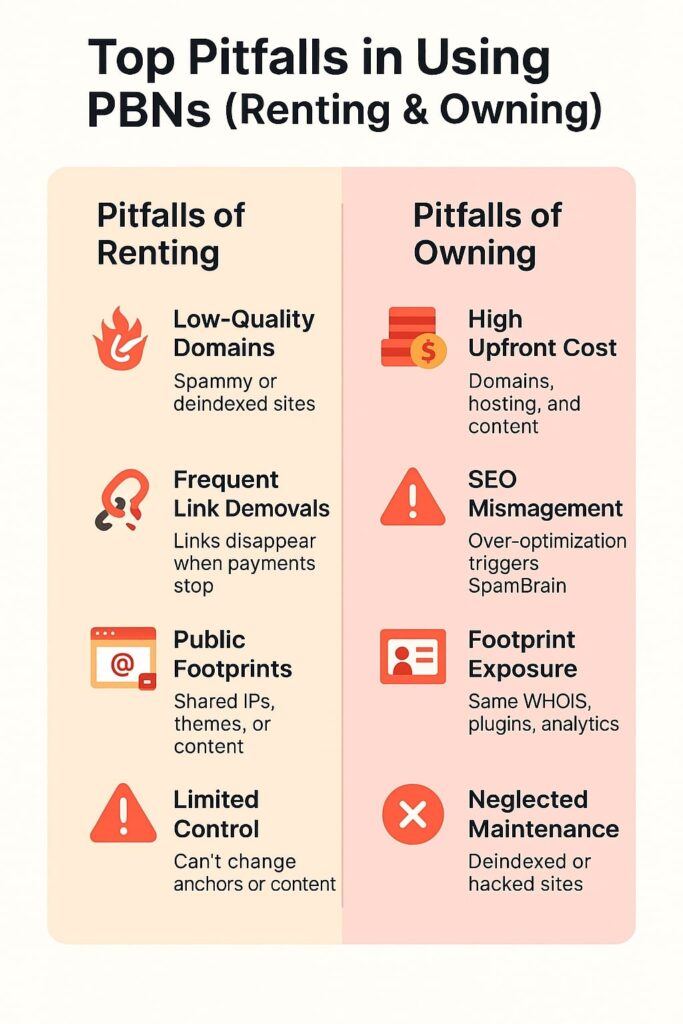
Over-optimized anchor text triggers penalties
Using exact-match keywords repeatedly (like “best SEO agency” on every link) makes your profile look unnatural. Google’s algorithms, including SpamBrain, can detect and penalize these patterns. Always vary your anchors—mix branded, partial match, and generic phrases.
Low-quality or deindexed domains weaken results
Some providers use expired domains with poor backlink histories, spammy content, or deindexing issues. Before renting or buying, check the domain’s history in the Wayback Machine, backlink profile via Ahrefs, and index status in Google.
Shared IPs and hosting footprints leave trails
When multiple PBN sites share the same IP address, CMS theme, or analytics tags, it becomes easier for search engines to detect a pattern. For owners, this means diversifying hosting and DNS setups. For renters, ask your provider about their footprint management practices.
Rented links disappear without notice
If you stop paying for a rented link, it may be removed suddenly, causing ranking drops. Some networks don’t notify you before removal. Make sure your provider offers contract transparency or a buffer period. To track changes, use tools like Ahrefs or PBN management tools.
Overused networks dilute link value
Some PBNs sell the same domains to hundreds of clients, which reduces link equity. Avoid providers that lack exclusivity or overpopulate their blogs with outbound links. Ideally, your PBN link should appear within niche-relevant content and have fewer than 10 outbound links per page.
Poor content and irrelevant context
Whether renting or owning, links buried in thin or irrelevant content won’t help rankings—and may hurt them. Ensure posts are at least 300–500 words, contextually relevant, and written in fluent English.
Lack of tracking and quality control
If you’re not monitoring link performance, index status, and backlink profile changes, you won’t know when things go wrong. Tools like BacklinkManager.io or GSC alerts can help maintain link health.
Neglecting white-hat balance
Relying solely on PBNs without supplementing with guest posts, digital PR, or branded anchors makes your link profile look artificial. Diversify your strategy to stay under the radar and build sustainable authority.
Best Practices for Renting PBN Links Safely
Renting PBN links can work—if done with caution. To protect your rankings and reputation in 2025, follow these essential best practices.
Choose trusted providers only
Work with reputable services that offer high-quality domains with clean backlink histories. Use tools like Ahrefs or Semrush to check Domain Rating (DR), spam score, and outbound link (OBL) volume. Avoid networks with dozens of links per page or recycled content. Always verify before you rent.
Monitor your rented links regularly
Track link status and indexation using tools like Ahrefs, SERPWatcher, or PBN management tools. This ensures you catch dropped or deindexed links quickly. UTM tracking can also help measure traffic impact.
Use natural anchor text distribution
Avoid overusing exact-match keywords. A safe profile might include 50% branded, 30% generic, and 20% partial-match anchors. This mimics natural link patterns and reduces the risk of triggering SpamBrain penalties.
Understand the contract before paying
Check terms for link duration, refund policies, and whether links are replaced if removed. Some networks remove links immediately after non-payment. Clarify all terms upfront.
Building Trust with Rented PBNs
To reduce risk and improve results, treat rented PBN links as one piece of a broader strategy—not the only piece.

Blend with real, organic backlinks
Use rented links in tandem with guest posts, niche edits, and other white-hat sources. This makes your profile more natural and less reliant on one method. See how to build PBN links that integrate well with safer tactics.
Prioritize branded and generic anchors
Skip exact matches like “buy backlinks.” Instead, use anchor text like your brand name, URLs, or terms like “click here.” These raise fewer red flags.
Focus on contextual relevance
Place links inside well-written, niche-relevant content—at least 300–500 words long. Avoid links in sidebars, footers, or boilerplate content that looks mass-produced.
Keep monitoring link health
Rented links may vanish without notice. Check indexation and placement regularly. If a link drops, contact your provider immediately to avoid ranking losses.
Alternatives to PBNs: Safer Options
White-hat SEO alternatives provide long-term value, greater safety, and alignment with Google’s guidelines. These are reliable paths for building authority and reducing risk.
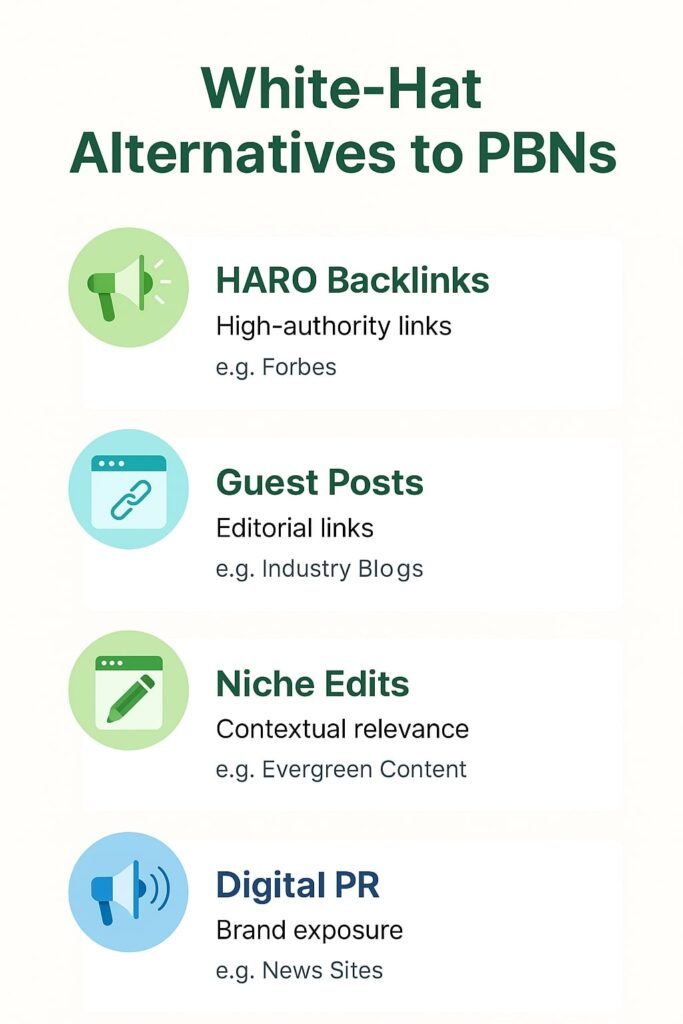
Guest Posting Networks
Get featured on high-quality blogs with editorial review. Platforms like guest post services help you place content on niche-relevant, established websites.
Niche Edits & Contextual Links
These involve placing links in aged, indexed content on authority sites. Because the content is already trusted, niche edits feel natural and often pass strong SEO value. They’re an ideal mid-tier option for risk-conscious SEOs.
HARO Links
Responding to media queries via Help A Reporter Out can earn you editorial backlinks from top publications. It’s competitive but very effective for branding and authority.
Digital PR & Outreach
Create shareable assets like studies or expert quotes and pitch them to journalists. It takes effort but earns links that are hard to replicate—and never penalized.
By combining these tactics with careful use of rented PBNs, you can create a more resilient and penalty-proof SEO strategy.
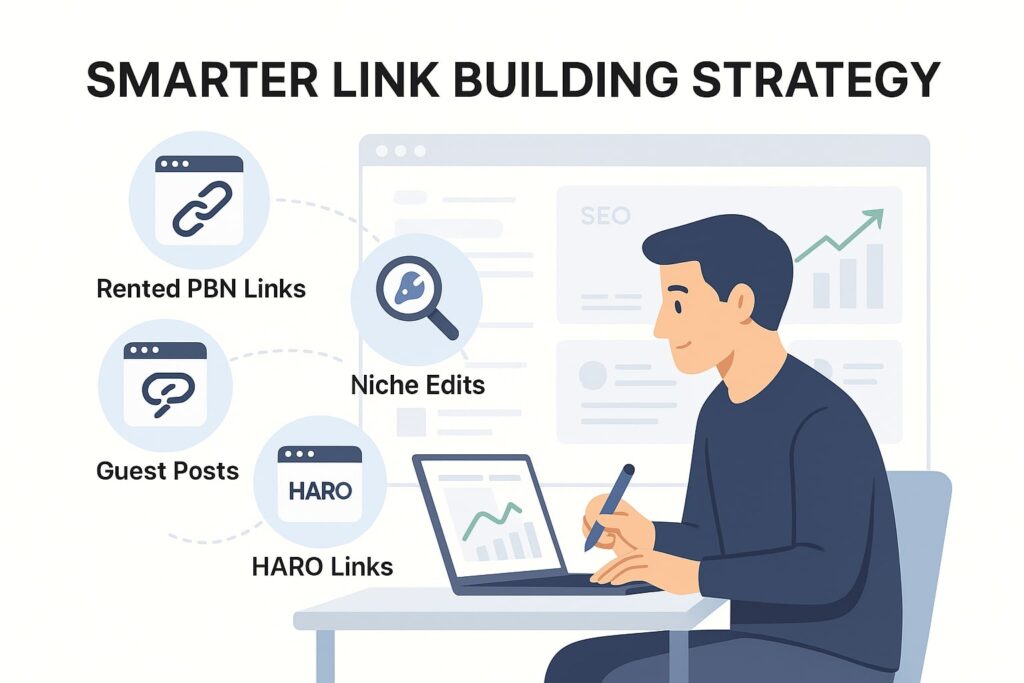
Conclusion
In conclusion, renting PBN links offers a quick, flexible way to gain SEO traction, especially for short-term projects or campaigns with limited budgets. Owning a PBN, on the other hand, provides full control and long-term value but demands more investment, technical skill, and ongoing upkeep. Each approach comes with its own set of risks from provider quality to potential Google penalties .This makes essential to evaluate your resources, goals, and risk tolerance before deciding.
To stay ahead in 2025, combine smart PBN usage with white-hat strategies like guest posts, niche edits, and contextual links for a balanced backlink profile.
Partner with T-RANKS to build smarter, safer link campaigns tailored to your SEO goals.
FAQs About Renting and Owning PBN Links
Do PBN links still work in 2025?
Yes, PBN links can still influence rankings in 2025 if used carefully. However, Google’s SpamBrain and manual reviewers are more advanced at detecting manipulative patterns. Use PBNs with clean domains, diverse anchors, and mix them with white-hat links to reduce risk.
Is renting PBN links better than owning them?
Renting PBN links is better for short-term SEO goals, while owning is better for long-term control. Renting is cost-effective and fast, but temporary. Owning requires technical know-how and ongoing maintenance but provides greater flexibility and value over time.
How long should I rent a PBN link?
The ideal rental period for PBN links is 3 to 6 months. This allows enough time to see ranking improvements without overspending. Avoid indefinite rentals unless performance is being tracked.
Are rented PBN links detectable by Google?
Yes, rented PBN links can be detected if they leave clear footprints or come from low-quality networks. Choose providers with unique hosting, real content, and limited outbound links. Use tools like Ahrefs and BacklinkManager.io to monitor risk.
What happens if I stop paying for a rented PBN link?
The link is usually removed, which may cause a drop in rankings. Make sure your provider outlines link duration and removal policies clearly in advance.
Is owning a PBN safe for SEO?
Owning a PBN carries risk but offers full control. You must avoid hosting footprints, duplicate WHOIS details, and thin content. When managed properly, a PBN can be a powerful long-term SEO asset.
How many PBN links do I need to rank?
The number of PBN links you need depends on your niche and competition. Typically, 5 to 20 high-quality links can improve mid-tier keywords. Learn more in our guide on how many PBN links to rank on Google.
What are the alternatives to using PBNs?
Alternatives include HARO, guest posting, niche edits, and digital PR. These white-hat strategies build long-term authority and reduce the risk of search engine penalties.
Can I track the performance of PBN links?
Yes, use tools like Ahrefs, Google Search Console, or BacklinkManager.io. Track anchor text, index status, and referral traffic to determine which links are effective.
How do I avoid PBN footprints?
Use different IPs, DNS setups, CMS themes, and content types across your sites. Never reuse WHOIS information or analytics codes. Consistency in diversity is key to staying undetected.
